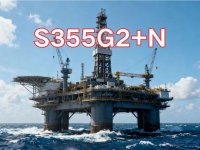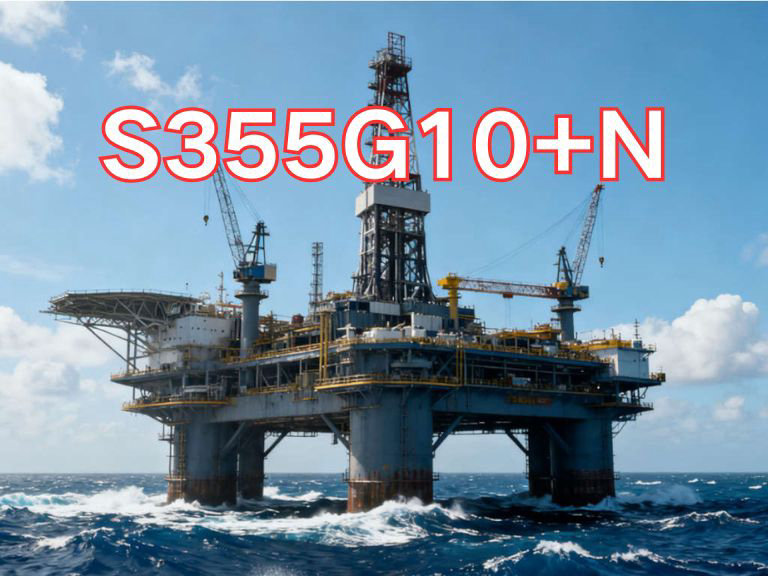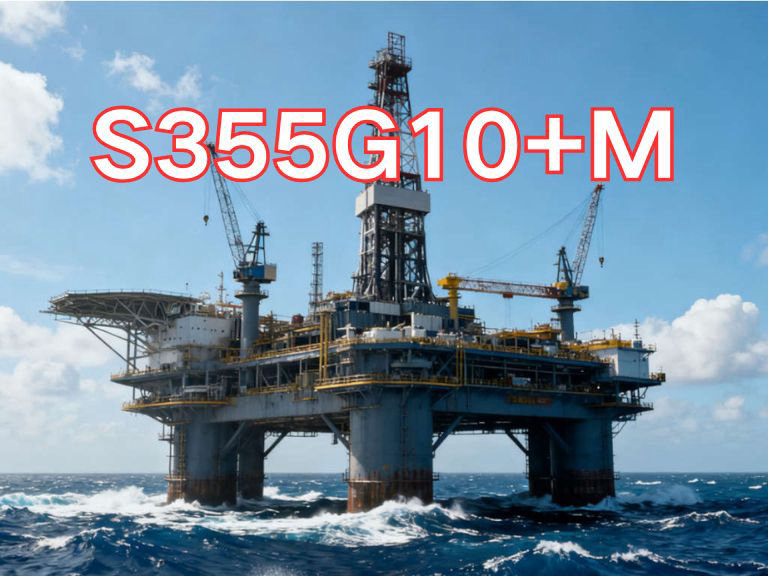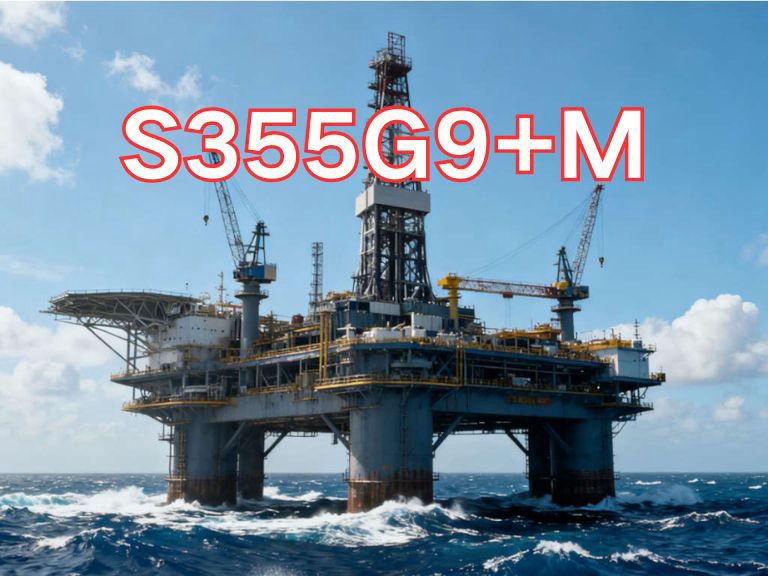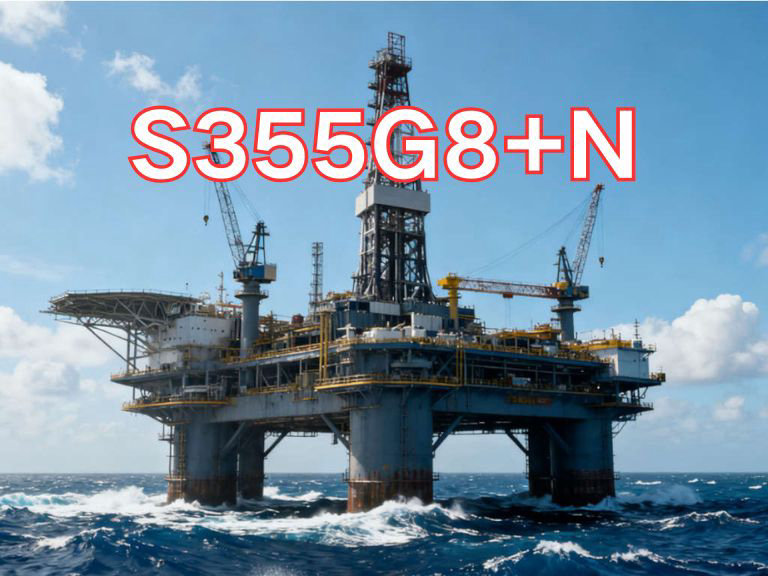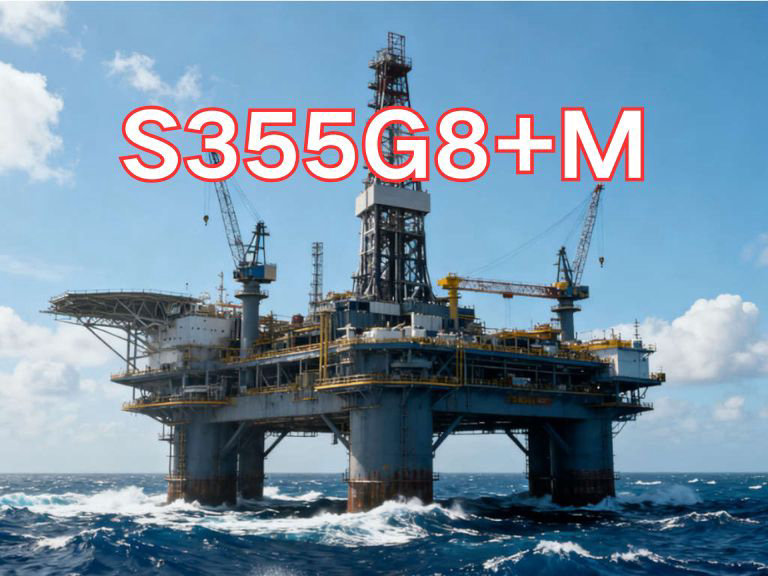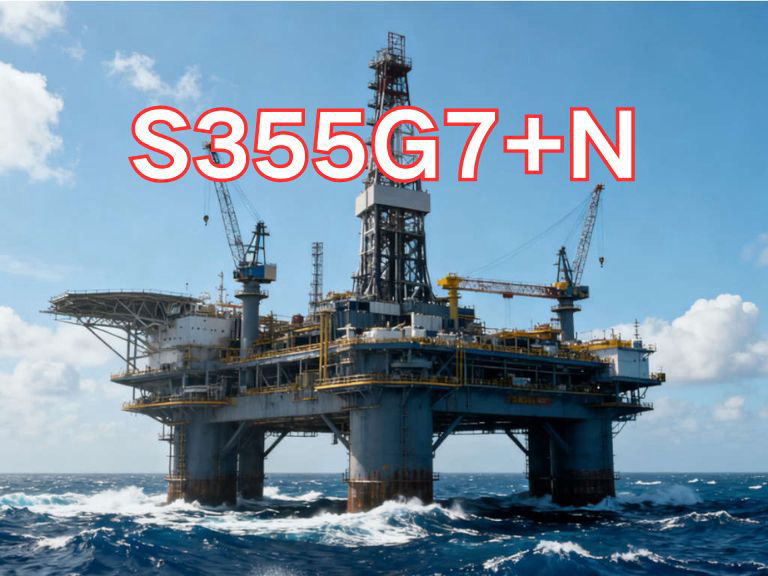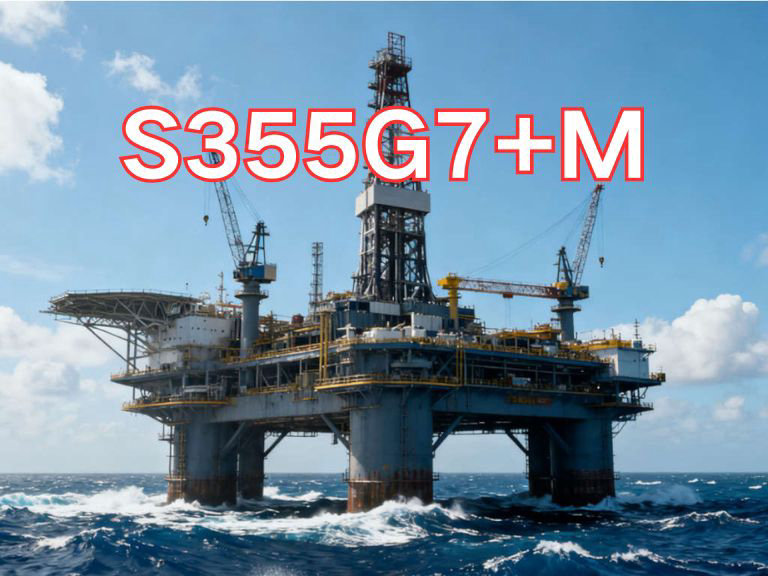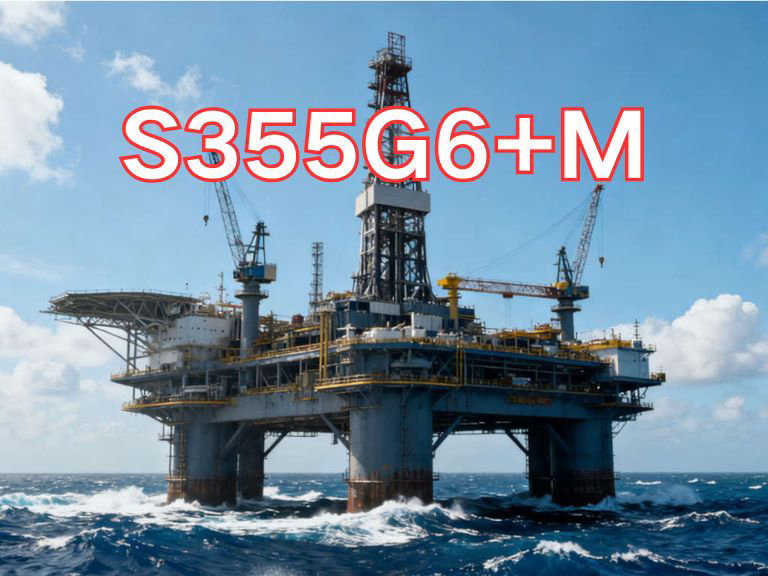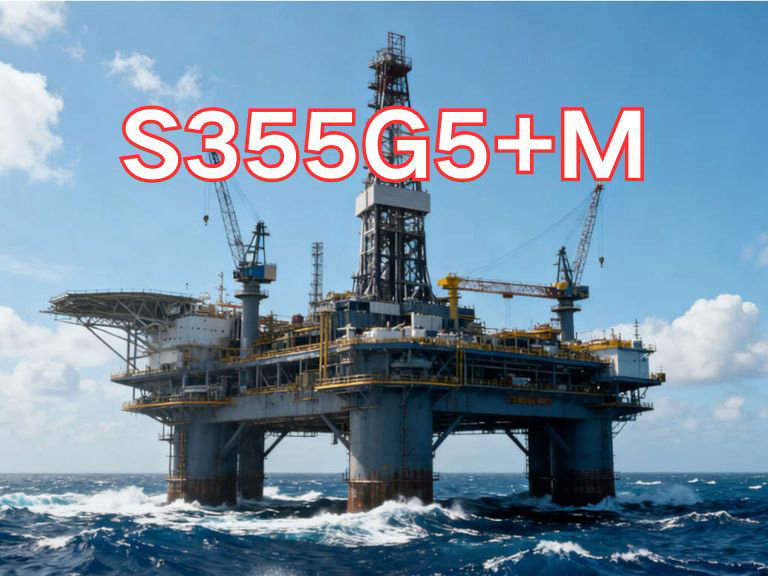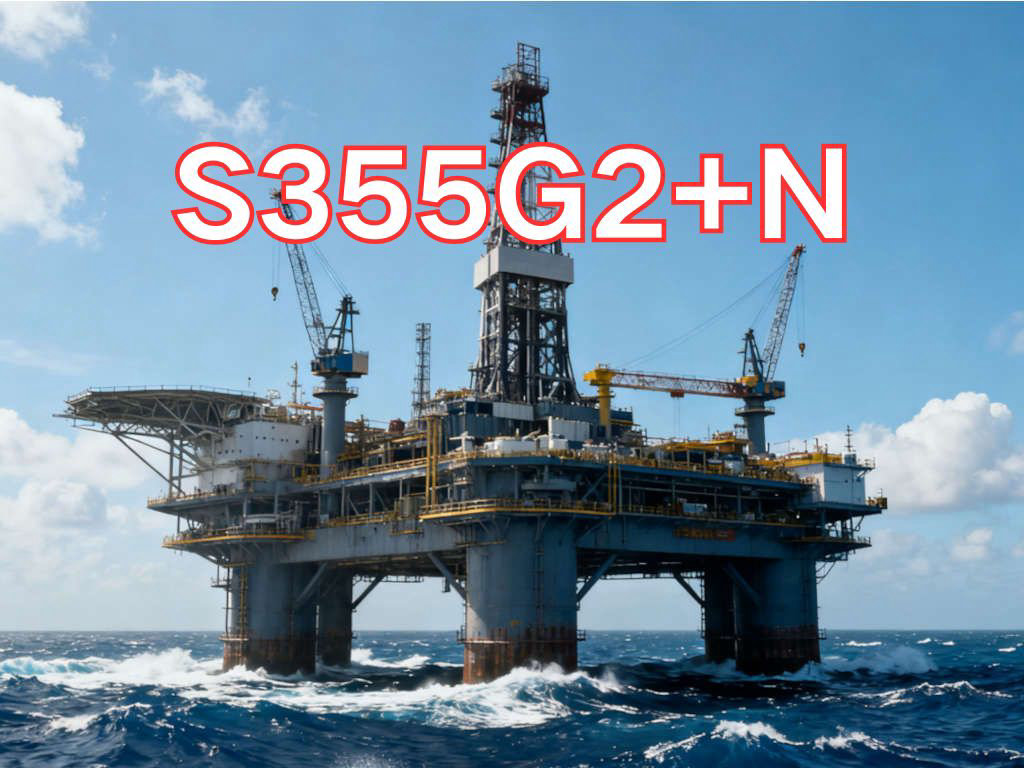

S355G2+N
S355G2+N is a high-strength weldable structural steel compliant with European standard EN 10225:2009. Delivered in normalized or normalized-rolled condition, it offers excellent low-temperature toughness (impact energy ≥50J at -20°C), and is widely used in offshore platforms, marine engineering structures, and sea-crossing bridges under severe environmental conditions.
Grade Designation Explanation
S: Structural Steel;
355: Minimum yield strength of 355 MPa at room temperature (for thickness ≤16 mm);
G2: Indicates steel for fixed offshore structures, requiring Charpy V-notch impact testing at -20°C with absorbed energy ≥50J;
+N: Delivery condition of normalization (Normalizing) or normalized rolling, which refines grain structure through controlled rolling and heat treatment to enhance mechanical properties.
Physical Properties
Density: 7.85 g/cm³
Elastic Modulus: ~210 GPa
Thermal Expansion Coefficient: ~12×10⁻⁶/°C (20–100°C)
Thermal Conductivity: ~50 W/(m·K)
Yield Strength (ReH):
Thickness ≤16 mm: ≥355 MPa
Thickness 16–25 mm: ≥345 MPa
Tensile Strength (Rm): 470–630 MPa (some standards specify 450–680 MPa)
Elongation after Fracture (A): ≥22% (Lo=50mm)
Low-Temperature Impact Toughness: Average absorbed energy ≥50J at -20°C (KV2)
Chemical Composition
S355G2+N is a low-alloy high-strength steel with strictly controlled chemistry to ensure strength, toughness, and weldability:
| Element | Content (wt%) | Function |
|---|---|---|
| C | ≤0.20% | Controls carbon equivalent to ensure weldability |
| Si | ≤0.50% | Deoxidizer, improves strength |
| Mn | 0.90–1.65% | Enhances strength and toughness, improves hardenability |
| P | ≤0.035% | Impurity, limited to reduce cold brittleness |
| S | ≤0.030% | Impurity, limited to minimize hot cracking risk |
| Cu | ≤0.35% | Improves atmospheric corrosion resistance |
| Cr | ≤0.30% | Enhances hardness and corrosion resistance |
| Ni | ≤0.50% | Improves low-temperature toughness |
| Mo | ≤0.10% | Increases strength and high-temperature performance |
| Nb | ≤0.06% | Grain refinement, improves strength and toughness |
| V | ≤0.12% | Precipitation strengthening, enhances strength |
| Ti | ≤0.03% | Fixes nitrogen, inhibits grain growth |
| Al | ≥0.02% | Strong deoxidizer, refines grain structure |
| N | ≤0.015% | Controls nitride precipitation |
Application Areas
S355G2+N is specifically designed for marine and offshore engineering, suitable for welded structures under high load, corrosive environments, and low temperatures:
Offshore Engineering: Oil & gas platforms, jacket structures, pile foundations, floating units;
Offshore Wind Power: Wind turbine towers, foundation support structures;
Sea-Crossing Bridges: Main girders, piers, connection nodes;
Port & Terminal Equipment: Cranes, loading platforms;
Ship Structures: Decks, bulkheads, hull reinforcements;
Lighthouses and Oceanographic Platforms exposed to long-term salt spray.
Testing and Manufacturing Methods
Production Process:
Steelmaking: Electric arc or converter steelmaking, followed by LF refining and VD vacuum degassing to reduce gases and inclusions;
Continuous Casting: High-purity slab production;
Heating: Uniform heating in soaking furnace to 1200–1250°C;
Rolling: Controlled rolling and cooling (TMCP) or normalized rolling for grain refinement;
Heat Treatment: Supplied in normalized or normalized-rolled condition for optimized microstructure;
Inspection:
Non-Destructive Testing (NDT): Ultrasonic testing (UT), graded per EN 10160 (e.g., S2:E2);
Mechanical Testing: Tensile, bend, and Charpy impact tests at -20°C;
Chemical Analysis: Spectrometry for composition verification;
Z-Direction Properties: Optional Z15, Z25, Z35 through-thickness tensile tests.
Equivalent or Similar Grades
| Standard System | Equivalent/Similar Grade | Notes |
|---|---|---|
| European (EN) | S355J2+N, S355NL, S355G1+N | Same strength level; G2+N is specific to offshore use with higher toughness (-20°C ≥50J); J2+N is general structural steel with ≥27J impact; NL for -50°C service. |
| American (ASTM) | ASTM A572 Gr.50, ASTM A709 Gr.50 | Similar yield strength (≥345 MPa), but lower toughness and welding requirements; not designed for offshore environments. |
| Japanese (JIS) | SM490YB, SM570 | SM490 series has similar tensile strength but lower impact toughness; SM570 is stronger but not optimized for marine use. |
| Chinese (GB) | Q355D, Q355E | Similar mechanical properties; Q355E has better low-temperature toughness (-40°C ≥34J), but lacks dedicated offshore specifications—requires technical agreement to meet EN 10225.. |
Note: S355G2+N outperforms general structural steels, especially in low-temperature toughness (≥50J at -20°C) and corrosion-resistant alloy design.
The S355G2+N steel grade was first introduced in EN 10225:2001, titled Weldable fine grain structural steels for welded offshore structures.
This standard was revised and superseded by EN 10225:2009, which refined chemical composition, mechanical properties, inspection requirements, and Z-direction performance, becoming the globally accepted technical reference for offshore engineering.
Thus, S355G2+N was first standardized in EN 10225:2001 and comprehensively enhanced in EN 10225:2009.

Ultrasonic Testing (UT)
A key non-destructive testing technique that uses high-frequency sound waves to detect internal flaws in steel plates. The probe emits sound waves, which reflect when encountering defects such as cracks or inclusions. The receiver captures the echoes, enabling precise determination of defect location and size. With high sensitivity, strong penetration, and fast inspection speed, UT effectively ensures internal quality, widely used in the production of heavy plates, pressure vessel plates, and other high-end products to guarantee safety and reliability.

Magnetic Particle Testing (MT)
A common surface inspection method that magnetizes the workpiece, causing leakage magnetic fields at surface or near-surface defects like cracks or inclusions, which attract magnetic particles to form visible indications. Simple to operate and highly sensitive, MT is suitable for rapid inspection of surface and near-surface flaws in ferromagnetic materials, widely used for online or offline inspection of plate edges, ends, and welds, ensuring product quality and safety.

Penetrant Testing (PT)
A non-destructive method for detecting surface-breaking flaws. A penetrant liquid is applied to the cleaned steel surface, allowing it to seep into defects such as cracks or pores. After removing excess penetrant, a developer is applied, causing the trapped penetrant to bleed out and form visible indications. Simple and cost-effective, PT is suitable for inspecting surface defects in various non-porous materials, commonly used for welds, castings, and complex components, effectively ensuring surface quality of steel plates.

